
Images By Shane Russeck
Shane Russeck was working out one day with legendary boxing trainer Freddie Roach at LA’s Wild Card Boxing Club when, on the spur of the moment, he picked up a camera and snapped a photo of Roach. It was that moment that kicked off his love for taking pictures, and which sent him down a path of celebrity and model photography. “I fell into that genre mainly because of where I was located in Los Angeles,” Shane explains. “But I never loved it. It was just a job.”
That changed when Shane started traveling to rodeos to photograph them for fun. From there, he segued into photographing wild mustangs, then Americana and “outlaw” culture, and it was then he realized he’d found his calling. “People always asked me why I didn’t photograph more at the boxing club, but there was always too much access for me to be drawn to that,” he says. “The adventure and discovery, the story behind the picture is just as important to me as the picture itself. I want to have to work for it, to explore, see new things, and photograph them. It’s my way of being a storyteller.”
His latest project has been a wildlife series, which so far has included the wild horses, bison, grizzly bears, and his personal favorite, wild orcas. “The orca is an animal that’s been very important to me and close to my heart,” he says. “The trips I take to the Pacific Northwest to photograph them are the most special out of all my wildlife shooting.”
Shane recently received the Tamron SP 150-600mm VC G2 lens, and he says he’s shooting some of his best work ever with it. “I’m so in love with that lens,” he says. “It’s phenomenal, especially the length at the 600mm end. For the first time, I can shoot from the distances I want to and not disturb anything that’s happening in front of me with the animals. I always handhold—usually it’s my dog and I heading out to a shoot, and we’ll just jump out of the car and start taking pictures—so the Vibration Compensation (VC) feature has been invaluable to get rid of camera shake. Plus, for such a large lens, it’s very lightweight and easy to travel with.”
There are a couple of reasons why Shane shoots his wildlife photos in monochrome. “First and foremost, I’m colorblind,” he says. “So I was always drawn to black-and-white imagery, and I prefer to edit my pictures that way. Plus, I like timeless photography. It’s important to me that when someone looks at my work, it’s hard to date it. Finally, I’m inspired by a lot of older photographers and tend to shoot timeless subjects that lend themselves to black and white, like rodeo cowboys and bikers.”
One of Shane’s hallmarks in his more adventurous style of image-making: not using remotes. “My way of doing this isn’t for everybody,” he says. “There are photographers out there doing amazing stuff that far surpasses what I’m doing, and they do use remotes, but it’s just not my style. I like to be right there in the middle of things. I’ve even flown in helicopters so I can take pictures of the mustangs from high up above, and people will ask me why I don’t just use drones. I explain to them it’s the excitement of being up in the helicopter that’s a big part of the process for me.”
When he heads out to photograph wildlife, what Shane is trying to capture depends on the individual species, and even of each animal itself. “Sometimes I’m looking to show the magnificence of what I’m seeing in that exact moment, like a group of wild horses running by,” he says. “I like going on journeys and seeing sights like that, and I want to share that with my viewers.”
When he takes a photo of an animal head-on, however, he always tries to achieve eye contact in the photo, as well as to put himself at a lower perspective to really offer a feel for the size of the animal. “And, of course, I like to capture the animal’s individual personality,” he says. “So if it’s a mountain lion, for instance, I want to show its natural beauty, but also its predatory aesthetic, because that’s what it’s known for.”
How much Shane tweaks the photo in post-processing depends on the photo. “The favorite photo I’ve ever taken, I did zero editing,” he says. “I just wanted people to see it for what it was. However, with other photos, I’ll play with the contrast and levels in Photoshop for hours, trying to get everything just right. Other times I’ll just use Photoshop to take out a distracting element. For instance, if I have an image of wild horses and there happens to be a power line in the photo, the image is going to look a lot better without the power line. Each photograph has a life of its own.”
Read on for the backstory for some of Shane’s favorite recent photos with the 150-600.
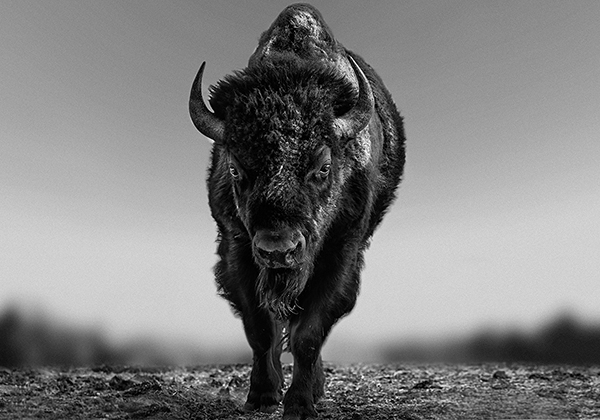
150-600mm (176mm), F/6.3, 1/250th sec., ISO 250
One of my goals for this photo was to shoot a bison from as low as possible, so I could really show the sheer mass and beauty of the animal. It was about 4 in the afternoon, with perfect lighting, and the bison was really easy—he posed for me like he was expecting it. I took this photo from about 15 feet away, and he wasn’t shy or skittish in the least. Bonus: I survived the encounter!
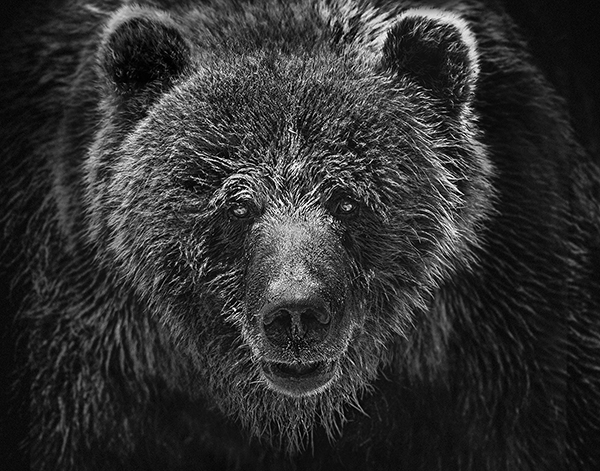
150-600mm (150mm), F/6.3, 1/320th sec., ISO 200
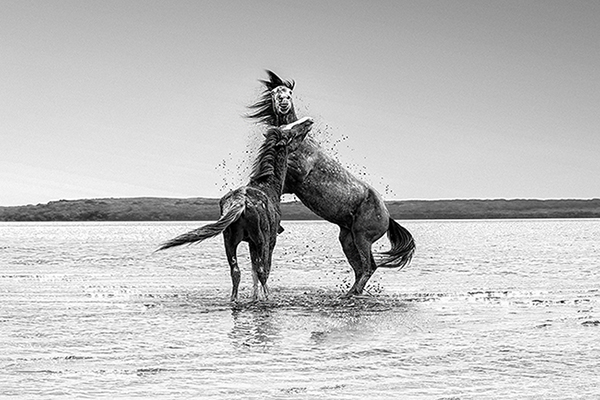
150-600mm (600mm), F/6.3, 1/640th sec., ISO 400
I give total credit to the 150-600 for being able to capture this. I had just come out of my car, and right as I looked up, with my camera in hand, this started happening. I believe if I’d been any closer, they wouldn’t have done this; they would’ve been more concerned with me than with each other. I was so happy and proud to capture a photo that you don’t often see. There are many images out there of horses running, or just staring at the camera, and those can, of course, be awe-inspiring as well. But when you capture two wild horses rearing up like that—to me, that’s America. That’s just as cool as it gets.
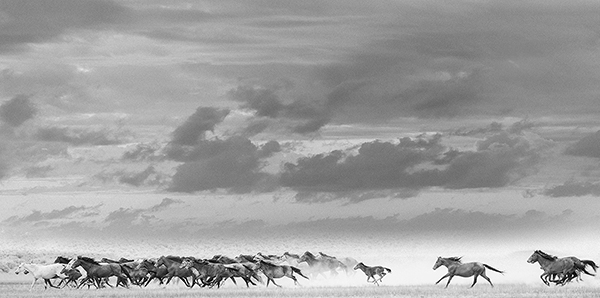
150-600mm (150mm), F/5, 1/500th sec., ISO 500
We had to drive way out onto the plains to shoot a film commercial, which was about an 8.5-hour car ride. When you get out there, you might not see another car pass by for two hours—it’s really remote. My idea was for the driver to cruise along the highway while I photographed the horses running on the plain. I knew it was a one-in-a-million shot I was trying to get, but I think we achieved it. Everything about this photo is what I love about shooting wild horses: It has that old Americana feel, that expression of American freedom.
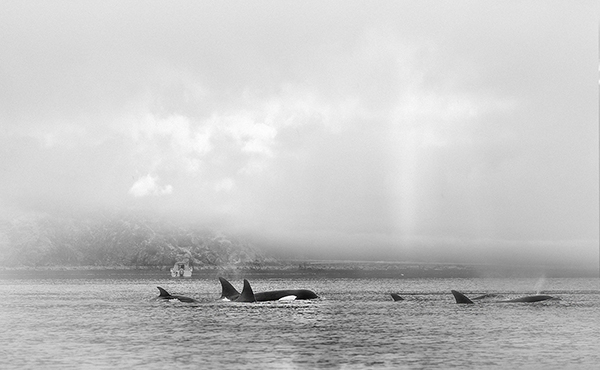
150-600mm (150mm), F/5.6, 1/500th sec., ISO 250
The orca pod you see in this photo are transient orcas, meaning they eat other marine mammals. Normally when I’m up there, I photograph the resident orcas. I’d never seen a pod of such large transient orcas, which apparently had come down from Alaska. This scene just captured that magical feeling I think of when I think of the Pacific Northwest, from the orcas swimming by to the boat with the fishermen in the background. It’s exactly the kind of shot I used to fantasize I’d get when I’d plan trips up there.
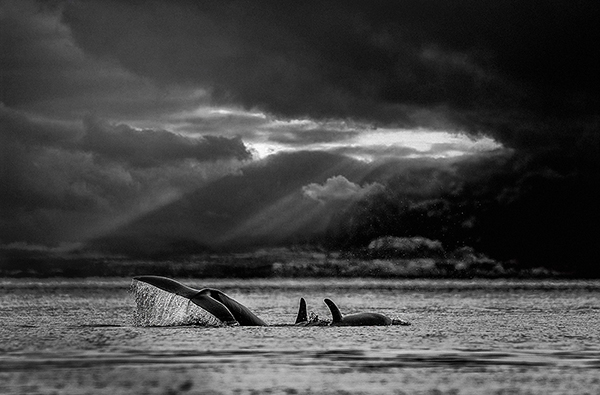
150-600mm (600mm), F/6.3, 1/500th sec., ISO 320
The inspiration for this final image came about three years ago, when the boat I was in had to turn around because someone got really seasick. I was upset we had to leave so early, but as the boat started heading back to shore, I turned and looked back at the orcas, and they were still playing and slapping their tails in the water. I started thinking about what it’s like after all the whale watchers leave for the day and what they’re still doing when there’s no one there to witness it. I thought about that concept each time I’ve gone back there, hoping I could re-create that in an image.
I got my chance after one long day in a Zodiac the last time I was up there. This photo of the tail slap, with the sun streaming through the clouds, captured that feeling for me. The sky was gorgeous, as was the water coming down off the tail. It was also a perfect memento, as that was the last photo I shot up there. It was a beautiful ending to our day on the water.
To see more of Shane Russeck’s images, go to www.shanerusseckphoto.com.
Exceptional capture in every shot. You truly captured the heart of America and the freedom we all cherish so much. If our wildlife can run free then we are free. Thanks for sharing